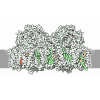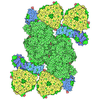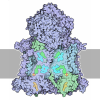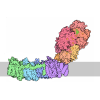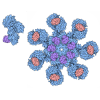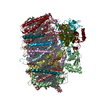+ Open data
Open data
- Basic information
Basic information
| Entry | Database: PDB / ID: 9g6h | ||||||||||||||||||||||||
|---|---|---|---|---|---|---|---|---|---|---|---|---|---|---|---|---|---|---|---|---|---|---|---|---|---|
| Title | active PSII dimer from native Peak4 PSII dimers | ||||||||||||||||||||||||
 Components Components |
| ||||||||||||||||||||||||
 Keywords Keywords | PHOTOSYNTHESIS / PSII / native intermediate / PSII assembly | ||||||||||||||||||||||||
| Function / homology |  Function and homology information Function and homology informationphotosystem II oxygen evolving complex / photosystem II assembly / oxygen evolving activity / photosystem II stabilization / photosystem II reaction center / photosystem II / oxidoreductase activity, acting on diphenols and related substances as donors, oxygen as acceptor / photosynthetic electron transport chain / photosystem II / response to herbicide ...photosystem II oxygen evolving complex / photosystem II assembly / oxygen evolving activity / photosystem II stabilization / photosystem II reaction center / photosystem II / oxidoreductase activity, acting on diphenols and related substances as donors, oxygen as acceptor / photosynthetic electron transport chain / photosystem II / response to herbicide / extrinsic component of membrane / chlorophyll binding / plasma membrane-derived thylakoid membrane / photosynthetic electron transport in photosystem II / : / phosphate ion binding / photosynthesis, light reaction / photosynthesis / respiratory electron transport chain / electron transfer activity / protein stabilization / iron ion binding / heme binding / metal ion binding Similarity search - Function | ||||||||||||||||||||||||
| Biological species |   Thermosynechococcus vestitus BP-1 (bacteria) Thermosynechococcus vestitus BP-1 (bacteria) | ||||||||||||||||||||||||
| Method | ELECTRON MICROSCOPY / single particle reconstruction / cryo EM / Resolution: 2.2 Å | ||||||||||||||||||||||||
 Authors Authors | Zhao, Z. / Vercellino, I. / Nixon, P.J. / Sazanov, L.A. | ||||||||||||||||||||||||
| Funding support |  United Kingdom, 2items United Kingdom, 2items
| ||||||||||||||||||||||||
 Citation Citation |  Journal: To Be Published Journal: To Be PublishedTitle: active PSII dimer from native Peak4 PSII dimers Authors: Zhao, Z. / Vercellino, I. / Nixon, P.J. / Sazanov, L.A. | ||||||||||||||||||||||||
| History |
|
- Structure visualization
Structure visualization
| Structure viewer | Molecule:  Molmil Molmil Jmol/JSmol Jmol/JSmol |
|---|
- Downloads & links
Downloads & links
- Download
Download
| PDBx/mmCIF format |  9g6h.cif.gz 9g6h.cif.gz | 1.2 MB | Display |  PDBx/mmCIF format PDBx/mmCIF format |
|---|---|---|---|---|
| PDB format |  pdb9g6h.ent.gz pdb9g6h.ent.gz | 1 MB | Display |  PDB format PDB format |
| PDBx/mmJSON format |  9g6h.json.gz 9g6h.json.gz | Tree view |  PDBx/mmJSON format PDBx/mmJSON format | |
| Others |  Other downloads Other downloads |
-Validation report
| Summary document |  9g6h_validation.pdf.gz 9g6h_validation.pdf.gz | 10.3 MB | Display |  wwPDB validaton report wwPDB validaton report |
|---|---|---|---|---|
| Full document |  9g6h_full_validation.pdf.gz 9g6h_full_validation.pdf.gz | 10.5 MB | Display | |
| Data in XML |  9g6h_validation.xml.gz 9g6h_validation.xml.gz | 209.2 KB | Display | |
| Data in CIF |  9g6h_validation.cif.gz 9g6h_validation.cif.gz | 288.9 KB | Display | |
| Arichive directory |  https://data.pdbj.org/pub/pdb/validation_reports/g6/9g6h https://data.pdbj.org/pub/pdb/validation_reports/g6/9g6h ftp://data.pdbj.org/pub/pdb/validation_reports/g6/9g6h ftp://data.pdbj.org/pub/pdb/validation_reports/g6/9g6h | HTTPS FTP |
-Related structure data
| Related structure data |  51102MC M: map data used to model this data C: citing same article ( |
|---|---|
| Similar structure data | Similarity search - Function & homology  F&H Search F&H Search |
- Links
Links
- Assembly
Assembly
| Deposited unit | 
|
|---|---|
| 1 |
|
- Components
Components
-Photosystem II ... , 16 types, 32 molecules AaBbCcDdHhIiJjKkLlMmOoTtUuXxYyZz
| #1: Protein | Mass: 39762.309 Da / Num. of mol.: 2 / Source method: isolated from a natural source Source: (natural)   Thermosynechococcus vestitus BP-1 (bacteria) Thermosynechococcus vestitus BP-1 (bacteria)References: UniProt: P0A444, photosystem II #2: Protein | Mass: 56656.457 Da / Num. of mol.: 2 / Source method: isolated from a natural source Source: (natural)   Thermosynechococcus vestitus BP-1 (bacteria) Thermosynechococcus vestitus BP-1 (bacteria)References: UniProt: Q8DIQ1 #3: Protein | Mass: 50287.500 Da / Num. of mol.: 2 / Source method: isolated from a natural source Source: (natural)   Thermosynechococcus vestitus BP-1 (bacteria) Thermosynechococcus vestitus BP-1 (bacteria)References: UniProt: Q8DIF8 #4: Protein | Mass: 39388.156 Da / Num. of mol.: 2 / Source method: isolated from a natural source Source: (natural)   Thermosynechococcus vestitus BP-1 (bacteria) Thermosynechococcus vestitus BP-1 (bacteria)References: UniProt: Q8CM25, photosystem II #7: Protein | Mass: 7358.754 Da / Num. of mol.: 2 / Source method: isolated from a natural source Source: (natural)   Thermosynechococcus vestitus BP-1 (bacteria) Thermosynechococcus vestitus BP-1 (bacteria)References: UniProt: Q8DJ43 #8: Protein/peptide | Mass: 4438.255 Da / Num. of mol.: 2 / Source method: isolated from a natural source Source: (natural)   Thermosynechococcus vestitus BP-1 (bacteria) Thermosynechococcus vestitus BP-1 (bacteria)References: UniProt: Q8DJZ6 #9: Protein/peptide | Mass: 4105.908 Da / Num. of mol.: 2 / Source method: isolated from a natural source Source: (natural)   Thermosynechococcus vestitus BP-1 (bacteria) Thermosynechococcus vestitus BP-1 (bacteria)References: UniProt: P59087 #10: Protein/peptide | Mass: 5028.083 Da / Num. of mol.: 2 / Source method: isolated from a natural source Source: (natural)   Thermosynechococcus vestitus BP-1 (bacteria) Thermosynechococcus vestitus BP-1 (bacteria)References: UniProt: Q9F1K9 #11: Protein/peptide | Mass: 4299.044 Da / Num. of mol.: 2 / Source method: isolated from a natural source Source: (natural)   Thermosynechococcus vestitus BP-1 (bacteria) Thermosynechococcus vestitus BP-1 (bacteria)References: UniProt: Q8DIN8 #12: Protein/peptide | Mass: 3981.673 Da / Num. of mol.: 2 / Source method: isolated from a natural source Source: (natural)   Thermosynechococcus vestitus BP-1 (bacteria) Thermosynechococcus vestitus BP-1 (bacteria)References: UniProt: Q8DHA7 #13: Protein | Mass: 29637.443 Da / Num. of mol.: 2 / Source method: isolated from a natural source Source: (natural)   Thermosynechococcus vestitus BP-1 (bacteria) Thermosynechococcus vestitus BP-1 (bacteria)References: UniProt: P0A431 #14: Protein/peptide | Mass: 3906.738 Da / Num. of mol.: 2 / Source method: isolated from a natural source Source: (natural)   Thermosynechococcus vestitus BP-1 (bacteria) Thermosynechococcus vestitus BP-1 (bacteria)References: UniProt: Q8DIQ0 #15: Protein | Mass: 15030.986 Da / Num. of mol.: 2 / Source method: isolated from a natural source Source: (natural)   Thermosynechococcus vestitus BP-1 (bacteria) Thermosynechococcus vestitus BP-1 (bacteria)References: UniProt: Q9F1L5 #17: Protein/peptide | Mass: 4322.226 Da / Num. of mol.: 2 / Source method: isolated from a natural source Source: (natural)   Thermosynechococcus vestitus BP-1 (bacteria) Thermosynechococcus vestitus BP-1 (bacteria)References: UniProt: Q9F1R6 #18: Protein/peptide | Mass: 5039.143 Da / Num. of mol.: 2 / Source method: isolated from a natural source Source: (natural)   Thermosynechococcus vestitus BP-1 (bacteria) Thermosynechococcus vestitus BP-1 (bacteria)References: UniProt: Q8DJI1 #19: Protein | Mass: 6766.187 Da / Num. of mol.: 2 / Source method: isolated from a natural source Source: (natural)   Thermosynechococcus vestitus BP-1 (bacteria) Thermosynechococcus vestitus BP-1 (bacteria)References: UniProt: Q8DHJ2 |
|---|
-Cytochrome b559 subunit ... , 2 types, 4 molecules EeFf
| #5: Protein | Mass: 9580.840 Da / Num. of mol.: 2 / Source method: isolated from a natural source Source: (natural)   Thermosynechococcus vestitus BP-1 (bacteria) Thermosynechococcus vestitus BP-1 (bacteria)References: UniProt: Q8DIP0 #6: Protein/peptide | Mass: 5067.900 Da / Num. of mol.: 2 / Source method: isolated from a natural source Source: (natural)   Thermosynechococcus vestitus BP-1 (bacteria) Thermosynechococcus vestitus BP-1 (bacteria)References: UniProt: Q8DIN9 |
|---|
-Protein , 1 types, 2 molecules Vv
| #16: Protein | Mass: 18046.943 Da / Num. of mol.: 2 / Source method: isolated from a natural source Source: (natural)   Thermosynechococcus vestitus BP-1 (bacteria) Thermosynechococcus vestitus BP-1 (bacteria)References: UniProt: P0A386 |
|---|
-Sugars , 2 types, 27 molecules 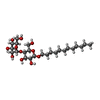
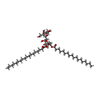

| #33: Sugar | ChemComp-LMT / #34: Sugar | ChemComp-DGD / |
|---|
-Non-polymers , 18 types, 1311 molecules 

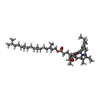

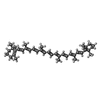
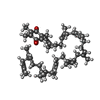
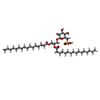



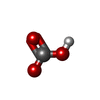
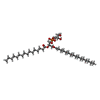
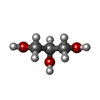
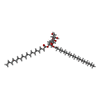





















| #20: Chemical | | #21: Chemical | ChemComp-CL / #22: Chemical | ChemComp-CLA / #23: Chemical | ChemComp-PHO / #24: Chemical | ChemComp-BCR / #25: Chemical | ChemComp-PL9 / #26: Chemical | ChemComp-SQD / #27: Chemical | ChemComp-PLM / #28: Chemical | ChemComp-LFA / #29: Chemical | #30: Chemical | #31: Chemical | ChemComp-LHG / #32: Chemical | #35: Chemical | ChemComp-LMG / #36: Chemical | ChemComp-HEM / #37: Chemical | #38: Chemical | #39: Water | ChemComp-HOH / | |
|---|
-Details
| Has ligand of interest | Y |
|---|---|
| Has protein modification | Y |
-Experimental details
-Experiment
| Experiment | Method: ELECTRON MICROSCOPY |
|---|---|
| EM experiment | Aggregation state: PARTICLE / 3D reconstruction method: single particle reconstruction |
- Sample preparation
Sample preparation
| Component | Name: active PSII dimer from Peak4 PSII dimer / Type: COMPLEX Details: PSII complexes were pulled down with the His tag at the CP47. The His-eluate was applied to ion exchange chromatography. Four fractions were eluted: Psb27/PSII monomer, oxygen-evolving PSII ...Details: PSII complexes were pulled down with the His tag at the CP47. The His-eluate was applied to ion exchange chromatography. Four fractions were eluted: Psb27/PSII monomer, oxygen-evolving PSII monomer, fully functional PSII dimer, and half oxygen-evolving functional PSII dimer. Only the half-functional PSII dimer was not characterised. This structure of active PSII dimer is from the half-functional dimer. Entity ID: #1-#19 / Source: NATURAL |
|---|---|
| Molecular weight | Experimental value: NO |
| Source (natural) | Organism:   Thermosynechococcus vestitus BP-1 (bacteria) / Cellular location: thylakoid membrane Thermosynechococcus vestitus BP-1 (bacteria) / Cellular location: thylakoid membrane |
| Buffer solution | pH: 6.5 Details: 20 mM MES pH 6.5, 2.5 mM MgCl2, 2.5 mM CaCl2, 7 mM MgSO4, 0.03% DDM, 0.05% CHAPS |
| Specimen | Conc.: 0.3 mg/ml / Embedding applied: NO / Shadowing applied: NO / Staining applied: NO / Vitrification applied: YES |
| Specimen support | Grid material: COPPER / Grid mesh size: 300 divisions/in. / Grid type: Quantifoil R0.6/1 |
| Vitrification | Instrument: FEI VITROBOT MARK IV / Cryogen name: ETHANE / Humidity: 100 % / Chamber temperature: 277.15 K |
- Electron microscopy imaging
Electron microscopy imaging
| Experimental equipment |  Model: Titan Krios / Image courtesy: FEI Company |
|---|---|
| Microscopy | Model: TFS KRIOS |
| Electron gun | Electron source:  FIELD EMISSION GUN / Accelerating voltage: 300 kV / Illumination mode: FLOOD BEAM FIELD EMISSION GUN / Accelerating voltage: 300 kV / Illumination mode: FLOOD BEAM |
| Electron lens | Mode: BRIGHT FIELD / Nominal magnification: 81000 X / Nominal defocus max: 2000 nm / Nominal defocus min: 600 nm / Alignment procedure: COMA FREE |
| Specimen holder | Cryogen: NITROGEN / Specimen holder model: FEI TITAN KRIOS AUTOGRID HOLDER |
| Image recording | Electron dose: 80 e/Å2 / Film or detector model: GATAN K3 BIOQUANTUM (6k x 4k) / Num. of grids imaged: 1 / Num. of real images: 9173 |
- Processing
Processing
| EM software |
| ||||||||||||||||||||||||||||||||||||||||||||
|---|---|---|---|---|---|---|---|---|---|---|---|---|---|---|---|---|---|---|---|---|---|---|---|---|---|---|---|---|---|---|---|---|---|---|---|---|---|---|---|---|---|---|---|---|---|
| CTF correction | Type: PHASE FLIPPING AND AMPLITUDE CORRECTION | ||||||||||||||||||||||||||||||||||||||||||||
| Particle selection | Num. of particles selected: 5900000 | ||||||||||||||||||||||||||||||||||||||||||||
| Symmetry | Point symmetry: C2 (2 fold cyclic) | ||||||||||||||||||||||||||||||||||||||||||||
| 3D reconstruction | Resolution: 2.2 Å / Resolution method: FSC 0.143 CUT-OFF / Num. of particles: 363811 / Symmetry type: POINT | ||||||||||||||||||||||||||||||||||||||||||||
| Atomic model building | Protocol: FLEXIBLE FIT / Space: REAL | ||||||||||||||||||||||||||||||||||||||||||||
| Atomic model building | PDB-ID: 3KZI Accession code: 3KZI / Source name: PDB / Type: experimental model | ||||||||||||||||||||||||||||||||||||||||||||
| Refine LS restraints |
|
 Movie
Movie Controller
Controller





 PDBj
PDBj